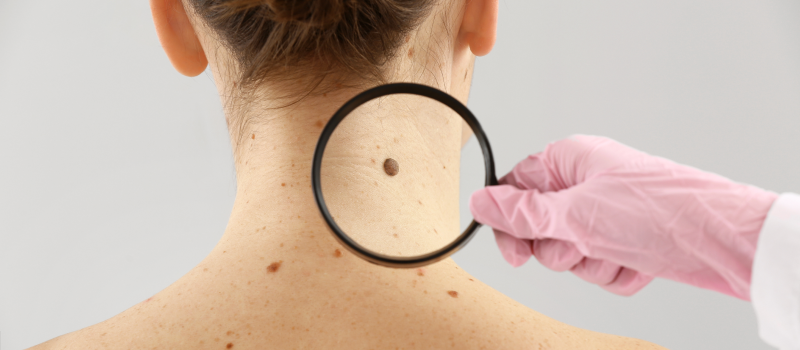Melanoma is a serious form of skin cancer that develops in the melanocytes, the cells responsible for producing melanin, the pigment that gives skin its color. Though it is less common than other skin cancers, melanoma is more dangerous because it is more likely to spread to other parts of the body if not caught early. Early detection and treatment are crucial for improving survival rates.
Symptoms
Melanoma can occur anywhere on the skin, including areas not exposed to the sun. Recognizing the symptoms early can significantly impact the effectiveness of treatment. Key symptoms include:
- New moles or growths: The appearance of a new mole or growth on the skin that changes in size, shape, or color.
- Changes in existing moles: Alterations in the size, shape, or color of an existing mole. The ABCDE rule helps identify concerning changes:
- Asymmetry: One half of the mole does not match the other.
- Border: Edges are irregular, ragged, or blurred.
- Color: The mole has varying colors such as shades of brown, black, tan, or even red, white, or blue.
- Diameter: The mole is larger than 6 millimeters (about the size of a pencil eraser).
- Evolving: The mole changes in size, shape, or color over time.
- Itching or tenderness: Moles that become itchy, tender, or painful.
- Bleeding or oozing: Moles that bleed, ooze, or develop a crust.
Causes
The exact cause of melanoma is not always clear, but several risk factors can increase the likelihood of developing the disease:
- Ultraviolet (UV) radiation: Excessive exposure to UV radiation from the sun or tanning beds significantly increases the risk of melanoma.
- Fair skin: Individuals with fair skin, light hair, and light-colored eyes are more susceptible to melanoma due to lower melanin levels.
- Family history: A family history of melanoma increases the risk of developing the disease.
- Personal history: Individuals who have had melanoma or other skin cancers in the past are at higher risk.
- Moles: Having a large number of moles or atypical moles (dysplastic nevi) increases the risk.
- Weakened immune system: People with weakened immune systems, such as those with HIV or organ transplant recipients, are at higher risk.
Diagnosis
Diagnosing melanoma involves several steps, starting with a physical examination and potentially followed by various tests:
- Physical examination: A dermatologist examines the skin for suspicious moles or growths.
- Dermatoscopy: A special magnifying device is used to examine the skin in greater detail.
- Biopsy: If a mole or growth appears suspicious, a sample of tissue is removed and examined under a microscope to confirm the presence of cancer cells.
- Imaging tests: If melanoma is confirmed, imaging tests such as X-rays, CT scans, MRI scans, and PET scans may be performed to determine if the cancer has spread.
Treatment
The treatment of melanoma depends on the stage and location of the cancer, as well as the patient’s overall health. Common treatment options include:
- Surgery: The primary treatment for melanoma, involving the removal of the tumor and some surrounding healthy tissue. In advanced cases, lymph nodes may also be removed.
- Immunotherapy: Drugs that stimulate the immune system to attack cancer cells. Commonly used immunotherapy drugs for melanoma include checkpoint inhibitors like pembrolizumab and nivolumab.
- Targeted therapy: Drugs that target specific genetic mutations within melanoma cells. BRAF inhibitors and MEK inhibitors are examples of targeted therapies used in melanoma treatment.
- Radiation therapy: High-energy beams are used to kill cancer cells. This is often used in cases where surgery is not possible or to relieve symptoms in advanced melanoma.
- Chemotherapy: The use of drugs to kill cancer cells. Chemotherapy is less commonly used in melanoma but may be an option for advanced cases.
Conclusion
Melanoma is a potentially deadly form of skin cancer that requires prompt and effective treatment. Awareness of the symptoms and risk factors, combined with regular skin checks and protective measures against UV radiation, can significantly reduce the risk of developing melanoma. Early diagnosis and a tailored treatment plan are crucial for improving survival rates and maintaining a good quality of life.
